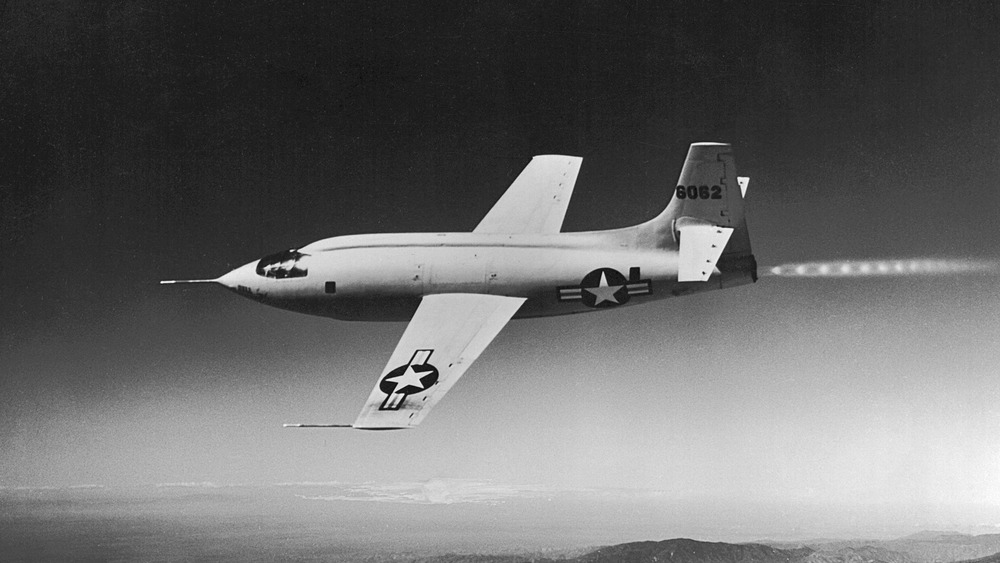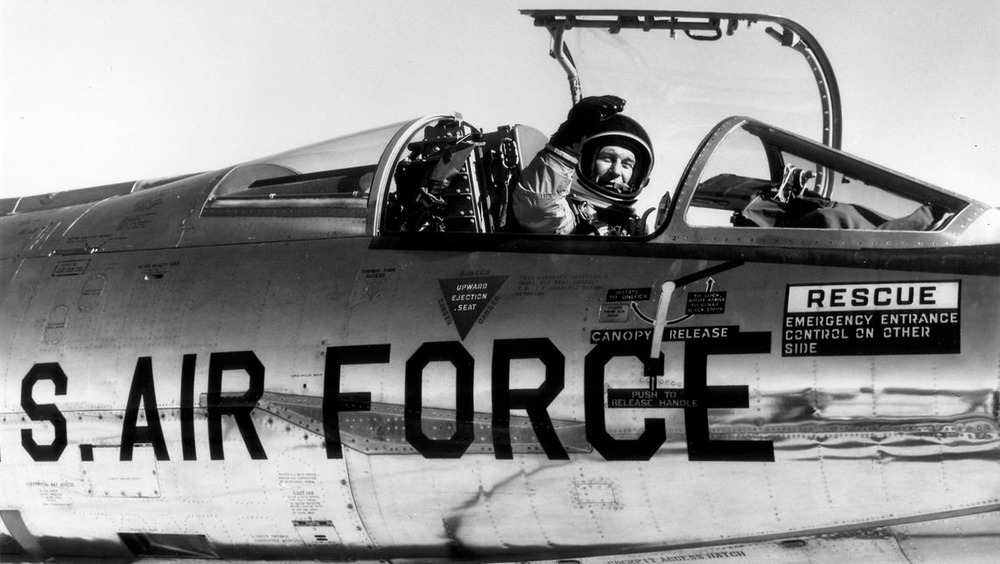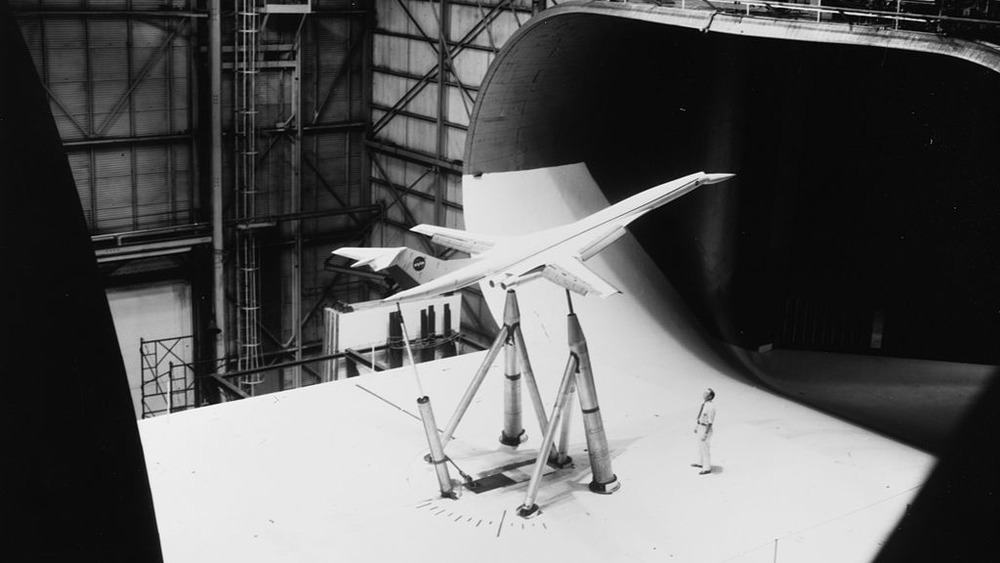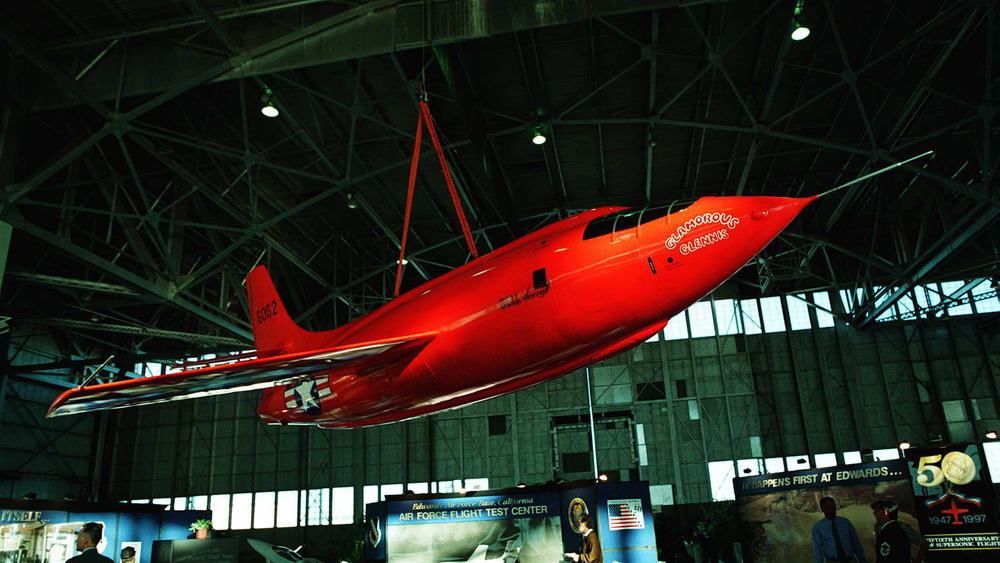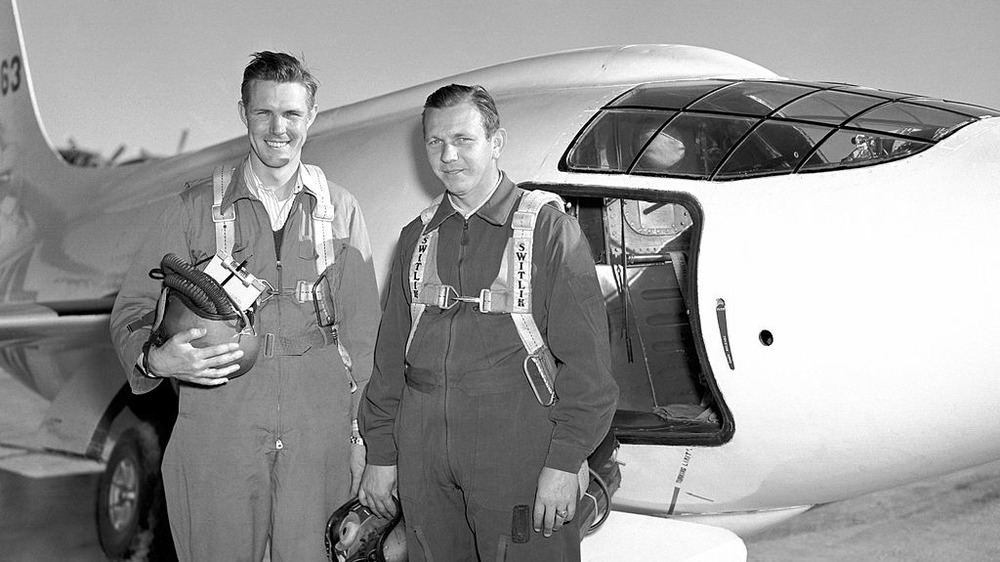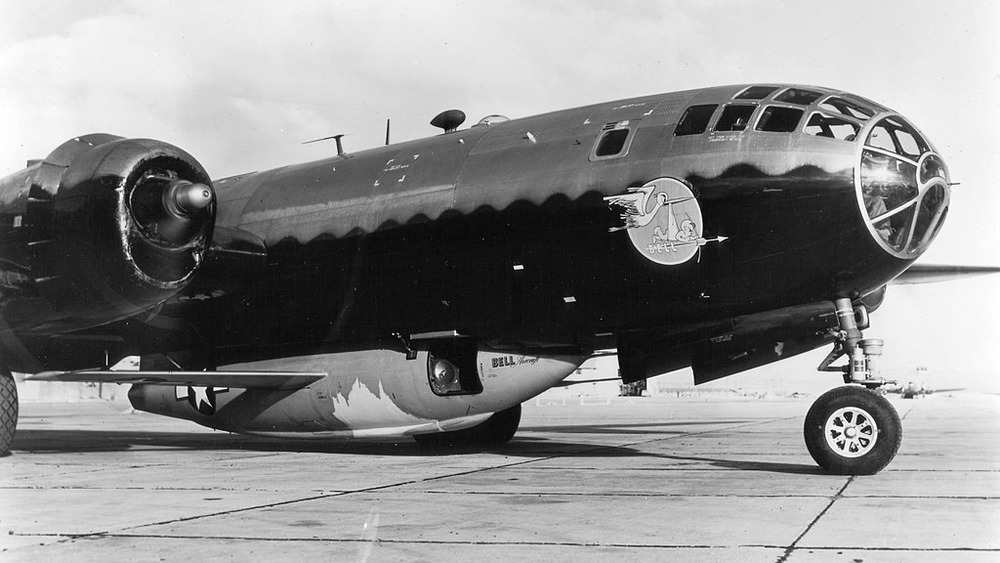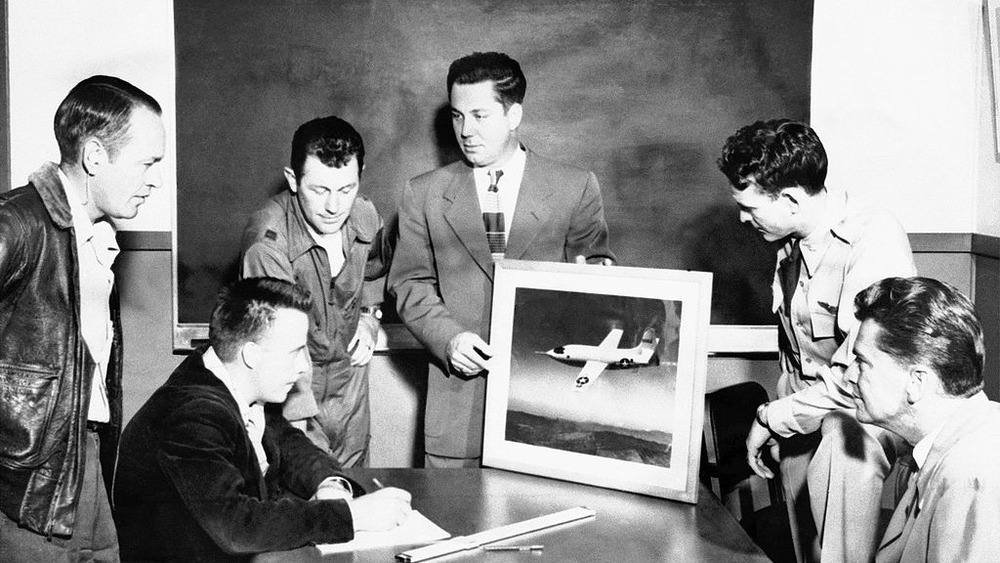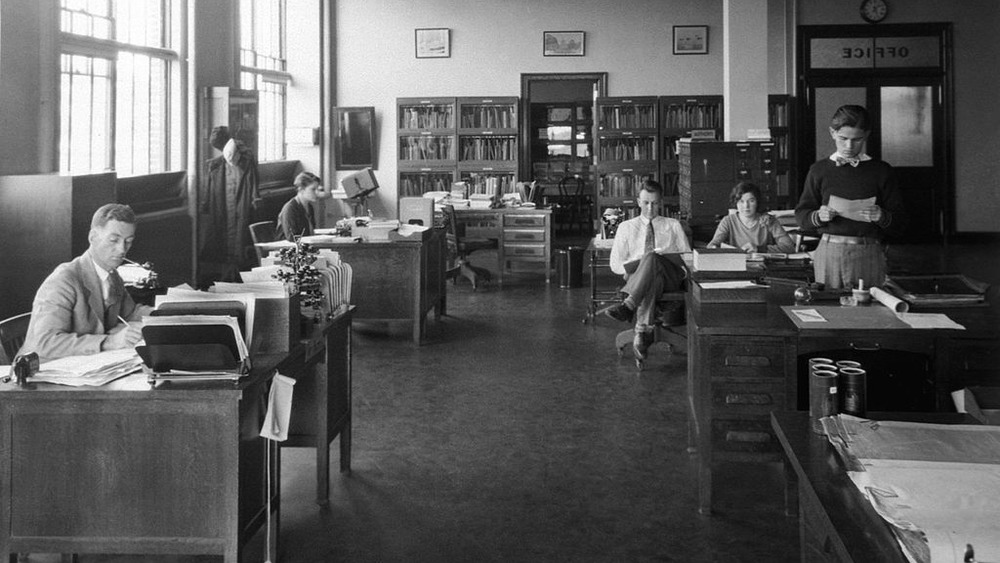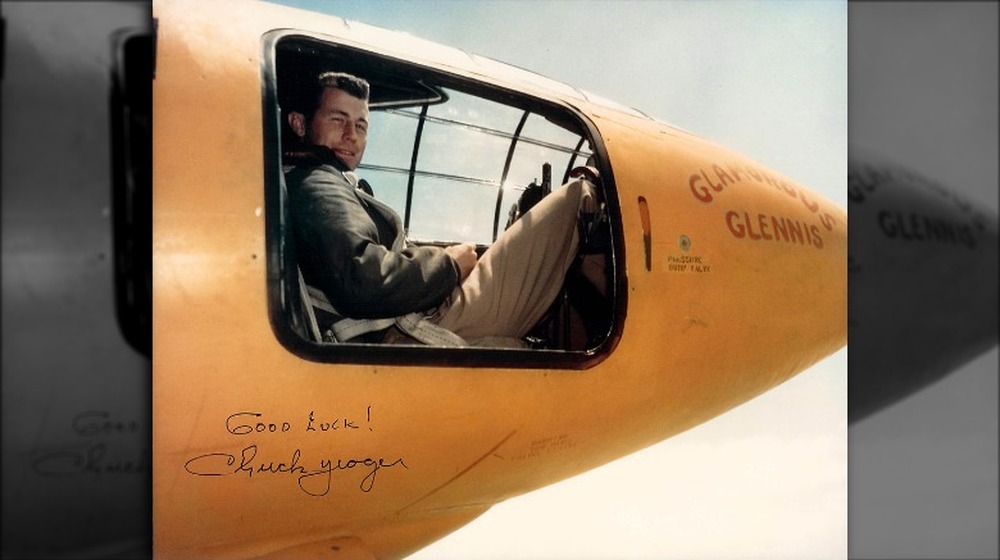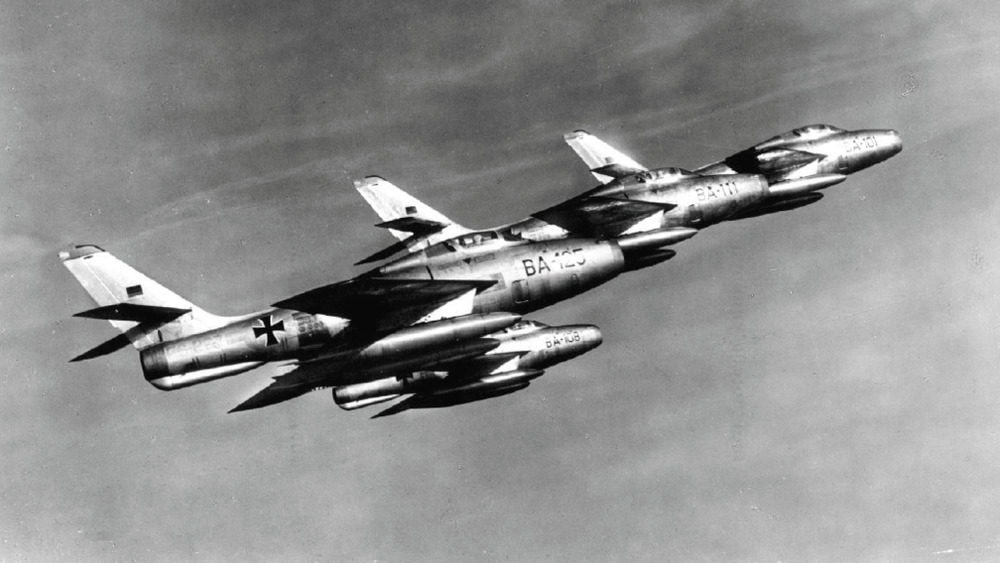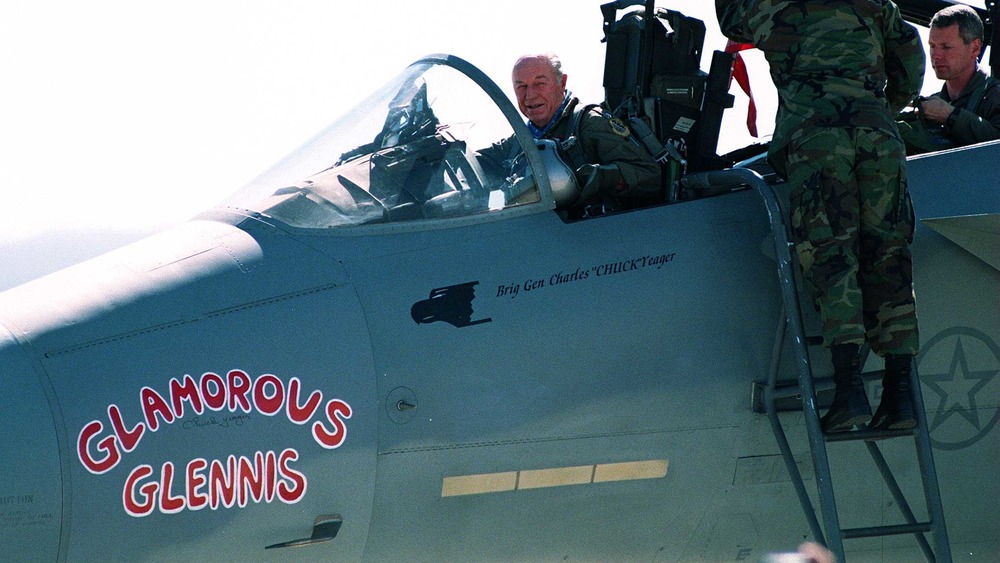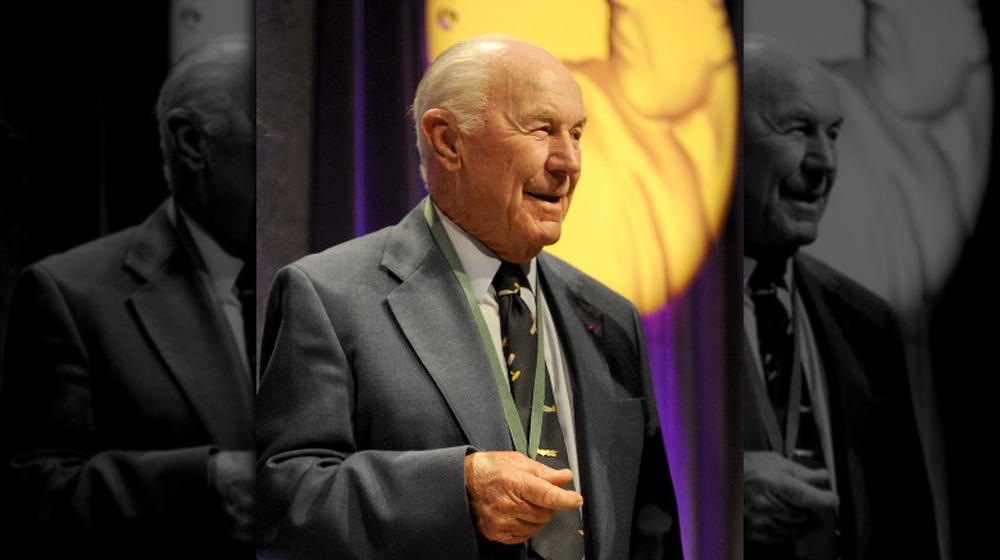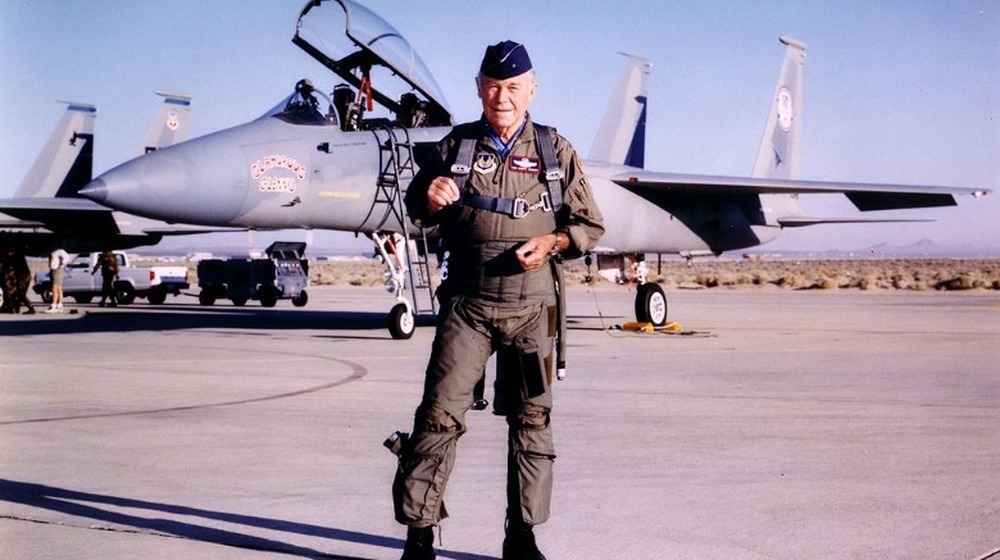What It Was Really Like To Break The Sound Barrier
People really like an adrenaline rush. Granted, that's not always true of everyone, but there's definitely some sort of fascination with the idea of just going fast, seeing the world whiz by in a blur of color. From sports cars to roller coasters, it's hard to say that there aren't at least some people who really want to test the limits of speed.
But going faster than sound itself? Now that's something that most people don't usually get to do, and before the mid-1940s, it was something nobody had been able to safely accomplish. People at the time thought it was pretty much impossible (via History). And yet, in the wake of the end of World War II, a team working with the United States Air Force shattered the odds and the sound barrier. Backed by a hefty amount of ingenuity, risk-taking, and maybe a little recklessness, the accomplishment became one of the best-known in the life of Chuck Yeager.
Chuck Yeager came from humble beginnings
For someone who would end up becoming one of the most recognizable names in all of aviation, Chuck Yeager has a pretty insanely modest origin story. As told by Yeager's official website, he was born on Feb. 13, 1923 in Myra, W.Va., a small town quietly tucked away in the Appalachians. He was generally an average student but with a knack for anything mathematical or mechanical.
With the U.S. entering World War II shortly after he graduated high school, Yeager enlisted in the military in 1941 to work as an airplane mechanic. That's right. He didn't enlist as a pilot. His first time in a plane actually left him airsick (via Associated Press). That said, he did end up joining a program that allowed enlisted men to train to become pilots.
That's where his impressive record began. His service in World War II included shooting down 13 German planes over the course of 64 missions — five of which were taken down in a single mission. He was shot down on a mission over France, but that clearly didn't stop him, and he escaped with the help of the French underground.
And Yeager was far from done with flying after the end of the war, going on to become a test pilot at Wright-Patterson Air Force Base in Dayton, Ohio. He later became one of a select group chosen to start flying the Bell X-1, with the intention of pushing toward supersonic flight (via History).
Breaking the sound barrier was a challenge
For (somewhat obvious) reasons, the U.S. military was invested in researching the possibility of supersonic flight, but it wasn't a problem that could be solved by just throwing funds at researchers.
Planes just seemed to have a problem with going near the speed of sound. For some reason, the plane would start experiencing more drag and turbulence while losing lift and control, but no one knew why at the start (via NASA and HistoryNet). All those effects taken together had already proven to end in disaster. Sometimes, the loss of control was too much for pilots to safely recover from, and the plane would just completely fall apart.
Even wind tunnels couldn't provide a safe solution. Just like with the planes, transonic (near the speed of sound) winds caused issues in a tunnel, bunching up around models and creating shockwaves, which rendered any data basically useless. Eventually, technology started catching up to research ambitions. A slot cut into the wind tunnels allowed shockwaves to escape, making for relatively safe testing conditions that gave reliable data. But there were other techniques that started getting used, too, like dropping models from high altitudes. Or attaching models to the wings of planes that dove toward the earth at Mach 0.75. Sure, the data was decent, but the conditions were dangerous at best.
The Bell X-1
Given the state of research into supersonic and transonic flight, it was clear that a special kind of aircraft was needed for the job. Enter the X-1. Made by Bell Aircraft, the X-1 was the first of its kind — a plane made specifically for research, not hindered by the restrictions of military or commercial use (via NASA). It was designed with the sole purpose of going fast.
And every part of its design was chosen with that goal in mind. The bright orange body was made to look like a 0.5 caliber machine gun bullet, because that particular shape seemed to remain stable at supersonic speeds. The wings were really thin, especially compared to other aircraft at the time but stuck straight out instead of sweeping back toward the rear of the plane (via HistoryNet). That swept back form would've prompted the wings to become shorter, making for an even more streamlined shape overall — great for aerodynamics but bad for stability. On top of that was a hefty propulsion system. Normal jet engines wouldn't do the job, so instead, they went with rocket engines and liquid oxygen. It's a pretty good amount of power for one plane.
The job of a test pilot
It's easy to imagine that the life of a test pilot tasked with breaking the sound barrier is just to fly fast and set new records, like a runner trying to set a personal best time. But it wasn't really like that, according to Bob Champine (via NASA). The pilots were actually given very specific tests to run, and they had to monitor a bunch of readings while performing certain maneuvers at a set Mach number. Then they would up that speed a little more and run it again. It was surprisingly routine, really.
But that didn't mean their jobs were easy or without risk. On the more mundane end, Chuck Yeager told Motortrend that piloting the X-1 wasn't exactly comfortable. Oxygen won't stay liquid unless it's really, really cold. And that liquid oxygen fuel was stored right behind the seat. The X-1 didn't come equipped with a heater, so the cockpit was just cold the whole time.
Plus, it was bolted shut with no way out, even if something went wrong, which is a scary thought. Yeager — a pilot who had flown in multiple wars — saw research flying as more dangerous than combat. In combat, at least there was skill and training to rely on. But the same wasn't true in research. Everything was untested, meaning that any random, unknown number of factors could unexpectedly cause disaster, and there wasn't much anyone could do about it. High risk, indeed.
There were also other pilots who sort of flew the X-1
A weird thing about the X-1? It didn't take off from the ground on its own. It would get loaded into another plane, then once that plane was in the sky, the X-1 would get dropped into the open air (via NASA). There were pilots aside from those who flew the X-1, and the whole endeavor was a team effort.
Pilots like Maj. Robert Cardenas was responsible for maneuvering the larger B-29 plane over the X-1, which would be strapped into the bomb bay (via HistoryNet). But then came the even harder part — taking off in a plane when there was another plane strapped underneath, barely two feet off the ground.
In the air, Cardenas and his copilot Jack Ridley would communicate with the test pilot and help them into the X-1's cockpit (a plane fitted into the bomb bay of another plane made for a tight squeeze), then release them so long as everything passed a final check. From there, two other chase planes were nearby, watching as the orange jet streaked by them.
The team in the air had to be ready for problems, too. Once, the X-1 didn't drop, and Cardenas had to make a perfect landing or else run the X-1 into the ground. Another time, Chuck Yeager's windscreen fogged up, and Dick Frost — a pilot of one of the chase planes — had to verbally guide Yeager to make a blind landing in the lake.
Breaking the sound barrier required a whole team
The technical know-how of the pilots was obviously impressive, but breaking the sound barrier required a bunch of other people with other areas of expertise. Jack Ridley and Dick Frost — a bright Caltech graduate and Bell's best X-1 engineer, respectively — were brought on for their vast amounts of technical knowledge (via HistoryNet). Chuck Yeager didn't have their understanding of the innate aerodynamics and mechanics at play in the situation, and that wealth of knowledge played a huge part in actually getting the X-1 to supersonic speeds.
The X-1 would have stability problems at speeds just below Mach 1, and the team had to find a way around that. It was Frost and Ridley who had the idea of making a part of the plane, the horizontal stabilizer, adjustable mid-flight. They only had observation and speculation to work with, but it worked.
And aside from the engineers, there were also all the mechanics like Jack Russell, who was responsible for keeping the plane's engines maintained and ready for use. He and the other mechanics would set out the night before a test flight to get everything prepped. That included strapping the X-1 into the larger B-29 and loading it with fuel, racing against the clock since the liquid oxygen boiled off immediately.
Another cool fact? Russell figured out a way to stop Yeager's windscreen from fogging up. His solution — a coating of shampoo inside the canopy. Who would've thought?
Breaking the sound barrier included breaking a few rules
For all the praise that the first supersonic flight has gotten, there's a decent chance that the team was upsetting other researchers and officials at the time. Initially, the Air Force was working with NACA (the precursor of NASA) for early tests of the X-1 (via NASA). But eventually, the Air Force wanted to push toward Mach 1 a lot faster than NACA was really comfortable with. The NACA researchers were more used to a cautious and measured approach, so to them, the Air Force was being reckless.
Aside from pacing, Robert Cardenas, the effective leader of the project, was pretty willing to take some serious risks. He would let the engineers bring the plane back into the hangar and make changes at night. One of those modifications was an adjustable stabilizer, which they hoped wouldn't instantly break in the air (via AVWeb and HistoryNet). Normally, he'd run a full structural analysis of the change, which would've taken weeks. But he'd been told to keep the whole operation "brief." And so he did, putting full trust in his team.
But Cardenas had to deal with another problem, too. A couple days before the Mach 1 flight, Chuck Yeager broke two ribs. He didn't tell anyone, but Cardenas found out and was faced with a dilemma. If anything happened to Yeager during the flight, the blame would fall on Cardenas, but he kept his mouth shut about it anyway, despite the possible consequences.
Chuck Yeager's record-breaking flight
It was Oct. 14, 1947, near Rogers Dry Lake at Muroc Airforce Base in Southern California (via History). Chuck Yeager had broken two ribs a couple days before in a horse riding accident but said nothing about it so that he wouldn't be grounded (via CNBC). Neither the pain nor the apprehension he later admitted to was about to stop him, as he used a sawed-off broomstick to close the cockpit of his bright orange X-1, affectionately nicknamed "Glamorous Glennis" after his first wife (via AP).
But, according to Yeager, despite the anxiety that led up to it, the test actually felt like a perfectly routine flight. He saw the indicator on his speedometer hit Mach 0.965, then suddenly jump off of it entirely as he hit Mach 1. Really, from his vantage point, it didn't even feel like going faster than the speed of sound. It felt more like just driving on a perfectly smooth road, which was surprising in and of itself. In later interviews, he went so far as to say that he probably could've gone even faster, if only he'd had more fuel.
Back on the ground, the team knew that Yeager's instruments had stopped giving readings at Mach 1.06 (about 662 mph), and everyone could hear the sonic boom ring through the air over the California desert (via HistoryNet).
Chuck Yeager's achievement was kept secret
For as incredible as supersonic flight is, the public wasn't allowed to know about it. No word of it got out initially, and the entire project was almost immediately labelled as top secret by the military (via NASA).
The reasons for that? Competition, mostly. Sure, World War II left the U.S. with a strong economy that could fund a massive aeronautical industry, but a similar thing could be said of other nations, namely the Soviet Union and Britain (via HistoryNet). So it just makes sense that all three nations were interested in the possibility of supersonic flight, especially with the fall of the Third Reich.
To say that Nazi Germany was technologically advanced is a pretty simple way to put it, but true all the same. The Germans had already been looking into ways to make planes fly faster, ranging from the first swept wing designs to a concept for a plane without a tail. Not all of those designs necessarily proved successful (a lot of them were unstable and killed their pilots), but they were all available to the biggest powerhouse nations in the aftermath of World War II. And all of those countries knew that was the case. By October 1947, the U.S. actually thought that the British might've done it first, hence the secrecy (via AP).
Of course, word did get out eventually. It started as a leak in December 1947, which the military finally confirmed in March the next year.
Chuck Yeager grew a reputation in his hometown
Once the news leaked of the achievement, Chuck Yeager became pretty well known — enough so that President Harry Truman presented him with the Collier air trophy in 1948 for his feat, one of many awards he would receive over his lifetime (via AP).
Back in West Virginia, he became a local celebrity, with schools, bridges, and even an airport named after him. But more than that, he kept up his status as the resident daredevil. People who lived in the town could remember when he would fly overhead, seemingly close enough to nearly take the roofs off of the buildings. Or when he flew under a bridge in Charleston at 450 mph, only to refuse to repeat the stunt "'cause the gunners will be waiting for you." His reputation as a daredevil was well earned, for sure.
And it's one that lasted. Even 40 years after breaking the sound barrier, Yeager returned to his hometown to mark the anniversary with a spectacular show of his skills, though the locals actually expected something even more daring. After all, they'd seen him swoop low enough to blow over whole corn fields or take the leaves off of trees (via AP). That sort of thing seems hard to forget.
What did Chuck Yeager think about all of this?
Despite the accolades and fame from becoming an effective celebrity in the world of aviation, Chuck Yeager stayed remarkably humble and down-to-earth. Being in the position he was and getting the opportunities that he did — to Yeager, that was all just a matter of luck and nothing more (via AP). He hadn't done anything special to get there, aside from being born at a time when aviation was starting to take off. It was all just a case of being in the right place at the right time.
As for his thoughts when people have asked him about having such a high-risk job, his answer was been pretty simple. It was his job, his duty, and that meant he would do it (via CNBC). There was no point in worrying about the risks, because what would worrying about death really accomplish in the long run? Fear didn't really do anything productive, so it was more helpful to think about what could be done to fix problems or to think about the rewards that could come at the end (via USA Today). After all, the way he saw it, even if he died, he wouldn't really know it anyway, so there wasn't a good reason to be scared. Fatalistic, yes, but there's a point.
Besides, he saw the sound barrier as the biggest obstacle to aviation at the time. In that situation, no risk was too great.
Chuck Yeager was still active long after breaking the sound barrier
Despite being part of a major accomplishment in the history of the human race, Chuck Yeager wasn't done just yet, and he continued flying long after breaking the sound barrier. He continued on as a test pilot, and just a few years later in 1953, he narrowly avoided death after going Mach 2.44, nearly two-and-a-half times the speed of sound (via HistoryNet). Not fazed, he went on with life as though nothing happened, because he had an event the next day (via USA Today). He also went back into combat, flying missions during the Vietnam War (via AP) before eventually retiring from the U.S. Air Force in 1975 as a brigadier general (via History).
Retirement didn't stop him from flying, though. He said in an interview in 1986 that he would keep on flying until he couldn't pass physicals anymore (via Motortrend), even recreating his famous flight in 2012 — 65 years later, exact to the minute — at age 89 (via Fox News).
It was his goal to live life to its fullest, because there was no point in living into old age without enjoying those years. Yeager died on Dec. 7, 2020, at the age of 97.
